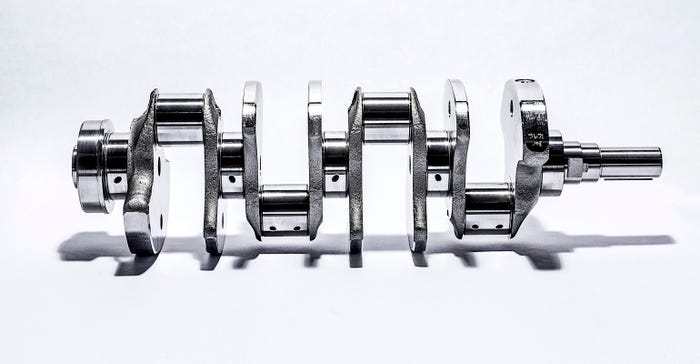Why does the arrangement of the crankshaft affect characteristics such as airflow and engine weight?

Most V8 engines employ what is known as a cross-plane crankshaft. The crank throws are set at 90-degree angles from one another so that the eight pistons rise and fall in staggered fashion to provide a smooth-running engine. The resulting rumbly exhaust note is the signature sound of the classic American muscle car V8, idling at a traffic light in anticipation of an impromptu drag race.
These engines provide the smooth running characteristics that drivers like, but they have some limitations in all-out performance applications. That is why serious sports cars like the Ferrari SF90 and its predecessor models do not use a cross-plane crankshaft in their V8s. Similarly, race cars have also long relied on flat-plane crankshafts, which space their throws 180 degrees apart so that they all lie in a single, flat plane.
In recent years, domestic carmakers have gotten on board with the benefits of flat-plane cranks despite their traditional use of cross-plane crankshafts. The 2016-2020 Ford Shelby GT350 Mustang famously used this configuration, as will the upcoming Chevrolet Corvette Z06.
The Mustang’s naturally aspirated 5.2-liter double-overhead-cam V8 produced an amazing 526 horsepower, for a power density of 102 hp per liter. The Corvette racing team has debuted a 5.5-liter flat-plane engine on the racetrack, and we anticipate something similar will soon appear beneath the engine cover of the production Corvette Z06 in place of the traditional cross-plane small block Chevy powerplant.
How does the crankshaft affect an engine’s power output? Engine mythology used to hold that long-stroke engines made more torque by virtue of the resulting longer lever arm on the crankshaft. But in reality, engine power output is determined by airflow into and out of the engine, and believe it or not, the crankshaft down in the bowels of the engine does influence airflow through the top of the engine.

With a flat-plane crankshaft, pistons in each bank of the engine rise and fall in pairs. This causes more vibration than a cross-plane crank would, but it has the effect of spacing cylinder firing so that exhaust pulses exit the ports and merge in the exhaust pipe with orderly, evenly spaced timing. This matters because having the pressure waves traveling down the exhaust system one at a time prevents them from crashing into each other, as they do with cross-plane crankshafts.
Evenly spaced exhaust pulses trail low pressure in their wake, and that low pressure helps evacuate spent exhaust gases from the next cylinder when its exhaust valve opens. This, in turn, helps that cylinder draw in its intake charge when the intake valve opens, during the overlap period when both intake and exhaust valves are open.
With a cross-plane engine, the pressure waves crashing into one another do not provide this benefit and can even send reverse pressure back up the pipe into the next cylinder and impede the evacuation of exhaust gases.
Better breathing means that flat-plane crankshaft engines can rev to higher rpm to make more power. And because they don’t need the counterbalancing weights required for cross-plane crankshafts, flat-plane cranks are lighter, which also makes it easier for the engine to spin faster.
The Ford Mustang GT350’s 8,250-rpm redline is the highest of any production engine in Ford history. This required an 87 mm throttle body, which was also the largest used in any production Ford when the GT350 debuted in 2016.
The different timing of the cylinders firing and the sequence of the exhaust pulses in an engine with a flat-plane crankshaft produces a much different sound than the familiar bass thunder of traditional American V8 engines. Instead, it is a higher-pitched tenor sound that is different, but also exciting.
“The Shelby GT350 program began with a clear objective – create the most balanced, nimble, and exhilarating production Mustang yet,” said Jamal Hameedi, then-Ford Performance chief engineer at the car’s launch. “Every change we made to this car was driven by the functional requirements of a powerful, responsive powerplant. The high-revving, naturally aspirated 5.2-liter flat-plane V8 delivers on every target we set – high horsepower, broad torque curve, aggressive throttle response, and light weight.”
It will be exciting to see what the Chevrolet engineers are cooking up for the Corvette Z06.
About the Author(s)
You May Also Like





